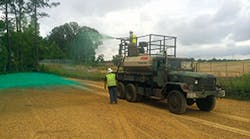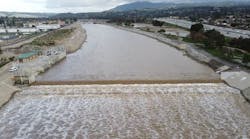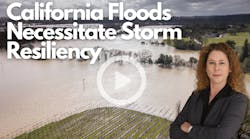As the global climate continues to change, the frequency and intensity of extreme weather events are increasing1. This poses significant challenges to our critical infrastructure, particularly those supporting our access to clean water and wastewater.
The aftermath of Hurricane Ian’s multi-billion-dollar devastation in Florida in 2022, unprecedented flooding in Vermont in July 2023 and the rampant wildfires that engulfed Maui in August the same year are stark examples of how vulnerable existing infrastructure is to extreme weather2. Artificial Intelligence (AI) can play a crucial role in better equipping infrastructure for resiliency by accurately predicting extreme weather, fortifying existing and greenfield infrastructure and improving water treatment efficiencies3,4. And investors are taking note. Experts project the market for AI-powered water and wastewater solutions will reach $6.3B by the end of the decade5.
AI in weather prediction
AI’s role in weather prediction has significantly evolved since the 1970s, with recent advancements in machine learning models contributing to unprecedented accuracy in forecasts6. One notable example is GraphCast, a machine learning model designed by Google’s DeepMind. With speeds 1,000–10,000 times faster than conventional models, GraphCast provides meteorologists with additional time to interpret and communicate weather predictions. Currently employed by the European Centre for Medium-Range Weather Forecasts, this tool predicted Hurricane Lee’s landfall in Nova Scotia this September nine days in advance of the storm. Conventional prediction models only projected landfall in Nova Scotia six days in advance of the storm7.
The significance of early detection cannot be overstated. Advance notice of storm activity can mean the difference between minor damage and catastrophic destruction and loss of life. With additional notice, utilities and infrastructure stakeholders can arrange for evacuations in projected overflow zones, prepare an alternative power supply in the event of power grid failure, isolate and protect the most vulnerable systems (like critical pump stations) and improve, repair or replace existing pumps to prevent wastewater backflows8.
The transformative impact of AI-powered weather prediction capabilities and stormwater management solutions underscores the potential to revolutionize disaster preparedness and resilience on a global scale.
AI in water treatment
AI can also revolutionize water management processes with data analytics, regression models, and advanced algorithms4. Current applications of AI in the water sector span a wide spectrum, offering solutions ranging from predictive maintenance of water infrastructure to forecasting water demand, consumption and the overall health of water reservoirs and dams. Additionally, AI contributes to monitoring water quality, detecting anomalies and predicting water-related disasters—providing a comprehensive toolkit for the modern water resource manager10.
Beyond predictive maintenance and water quality monitoring, AI also contributes to significant cost savings and resource optimization for utilities. By facilitating more informed decision-making for treatment plant operators, AI empowers leaders to proactively address maintenance and reduce overall operational expenditures. Furthermore, in an industry that consumes 2% of U.S. power each year, AI can identify opportunities for energy conservation, contributing to both economic and environmental sustainability11.
AI in Infrastructure Design
In the critical infrastructure industry, a new wave of companies is harnessing the power of AI and generative design to revolutionize design and construction processes, prioritizing innovation and sustainability. These tools help capital planners, project developers, and engineering professionals to rapidly generate preliminary engineering designs for critical infrastructure.
Generative design expedites the project initiation phase, providing a more streamlined pathway from conceptualization to implementation. This is particularly beneficial in an industry where projects are historically delayed due to resource constraints, breathing new life into long-stymied projects.
Moreover, generative design facilitates early-stage assessments of project environmental outcomes. This includes gauging factors such as carbon footprint, resilience to extreme weather events, and potential impacts on local communities, as early as the conceptual design phase12. For instance, consider a major water treatment project situated in a coastal area prone to saltwater intrusion and hurricane activity.
With generative design, project planners can simulate various site configurations and treatment processes, assessing the resilience of each design against extreme weather events, population change and rising sea levels. Not to mention, generative design also empowers decision-makers to break beyond the mold of previously developed designs—considering alternative materials, construction methods and emerging or unconventional technologies. Engineers can then make the most informed and proactive decisions on final site plans, treatment processes, technology integrations and equipment purchases to meet current and future needs.
In one example of the technology in action, Asia Development Bank leveraged the Transcend Design Generator (TDG), a generative design platform for water, wastewater and electrical substation infrastructure, to develop more than 10 treatment plant options within a timeframe of 8-12 weeks. This expedited process is a stark contrast to the conventional infrastructure design timeline of 8-10 months for similar projects. Several design options generated by the TDG also demonstrated a 50% reduction in land requirements. This success story highlights the tangible benefits of embracing AI-driven design, offering a glimpse into the future where innovation and sustainability are seamlessly integrated into the fabric of infrastructure development.
Conclusion
In our current landscape of constrained federal infrastructure budgets and a rapidly evolving climate, AI tools are no longer a ‘nice to have’ – they are a need to have. A paradigm shift in our approach to infrastructure management is essential. We owe it to ourselves and future generations to leverage technology like AI and generative design to better manage existing water assets and build new, resilient infrastructure. By integrating these technologies into our infrastructure planning, we actively contribute to a new legacy of sustainable development.
References
- “Extreme Weather and Climate Change,” Global Climate Change, NASA, https://climate.nasa.gov/extreme-weather/
- Lisa Bucci, et al., “Hurricane Ian,” National Hurricane Center Tropical Cyclone Report, NOAA, National Weather Service, April 3, 2023, https://www.nhc.noaa.gov/data/tcr/AL092022_Ian.pdf.
- Hamid Mehmood, et al., “Strategic Foresight to Applications of Artificial Intelligence to Achieve Water-related Sustainable Development Goals,” United Nations University Institute for Water, Environment and Health, 2020, https://inweh.unu.edu/wp-content/uploads/2020/04/Strategic-Foresight-to-Applications-of-Artificial-Intelligence-to-Achieve-Water-related-Sustainable-Development-Goals.pdf.
- Julia Edinger, “Two Cities Share How AI Is Improving Their Water Utilities,” Government Technology, March 31, 2021, https://www.govtech.com/analytics/two-cities-share-how-ai-is-improving-their-water-utilities.html.
- “AI for water: 10 ways AI is changing the water industry,” Autodesk Water, Autodesk, May 1, 2022, https://www.autodesk.com/blogs/water/2022/05/01/ai-in-water-10-ways-ai-is-changing-the-water-industry/?redirected=1.
- Sarah Sicard, “Here’s How AI Will Change The Future Of Weather Forecasting,” SlashGear, November 28, 2023, https://www.slashgear.com/1455627/how-ai-change-future-weather-forecasting/?zsource=msnsyndicated.
- Remi Lam, “GraphCast: AI model for faster and more accurate global weather forecasting,” Google DeepMind, November 14 2023, https://deepmind.google/discover/blog/graphcast-ai-model-for-faster-and-more-accurate-global-weather-forecasting/.
- “Climate Impacts on Water Utilities,” Climate Change Adaptation Resource Center (ARC-X), United States Environmental Protection Agency, July 31, 2023, https://www.epa.gov/arc-x/climate-impacts-water-utilities#storms.
- Meenu EG, “The Promise of Artificial Intelligence in Water Management,” Analytics Insight, February 17, 2021, https://www.analyticsinsight.net/the-promise-of-artificial-intelligence-in-water-management/.
- “AI for water: 10 ways AI is changing the water industry,” Autodesk Water, Autodesk, May 1, 2022, https://www.autodesk.com/blogs/water/2022/05/01/ai-in-water-10-ways-ai-is-changing-the-water-industry/?redirected=1.
- Transcend, https://transcendinfra.com/about/.







